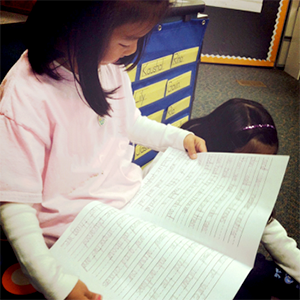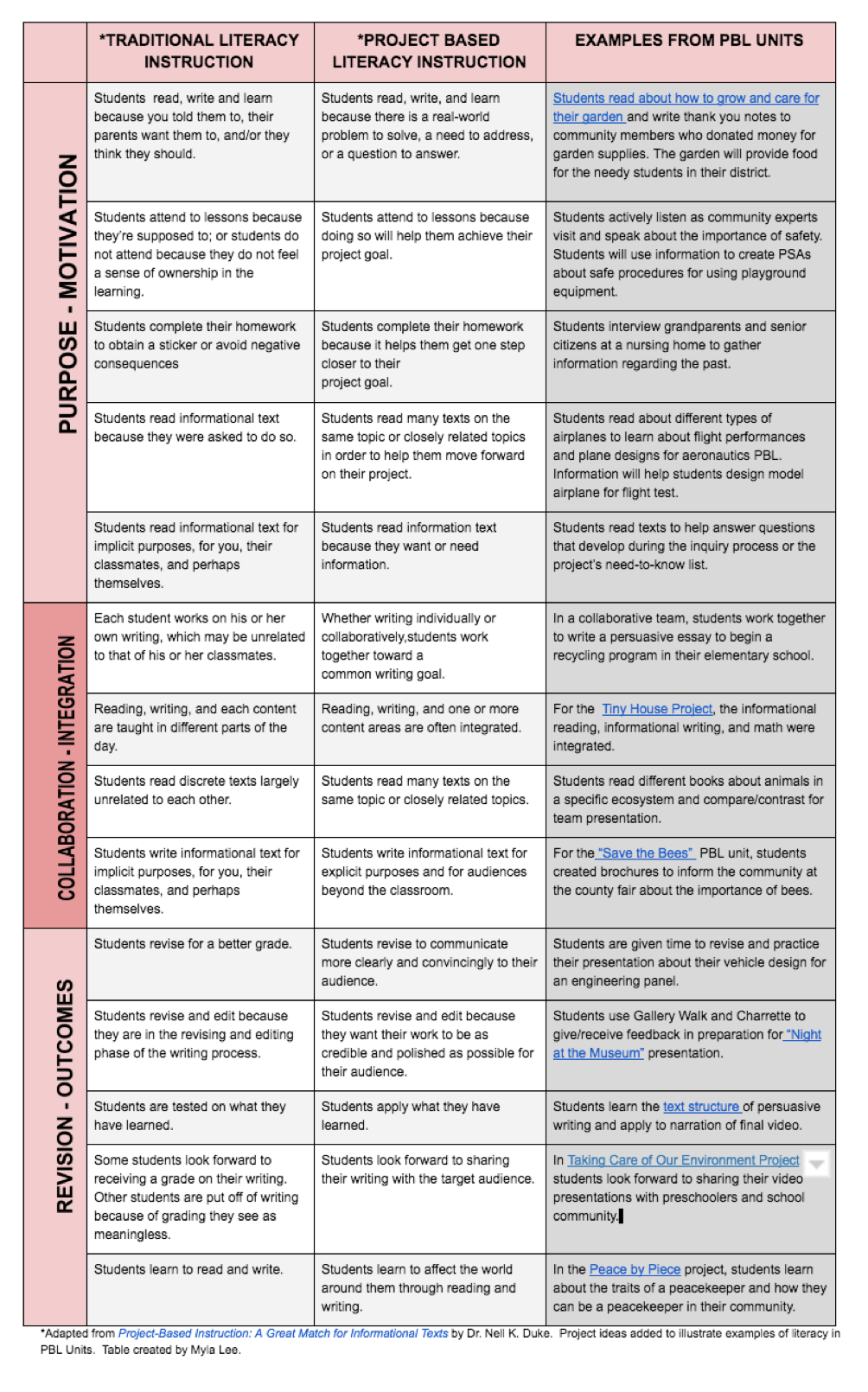
At a workshop I recently facilitated, I had a conversation with an elementary teacher who told me that she didn’t have time to do Project Based Learning in her classroom. This teacher explained that she had to dedicate 45-60 minutes each to science, social studies, reading, and writing in order to meet demands while fitting it all in the school day. She seemed to question how she could manage teaching her literacy content within PBL. Another teacher who taught first grade came up to me the following day and wondered how her students would be able to research and complete a project when half of them couldn’t read or write. In my years of facilitating and coaching PBL teachers, I’ve found these are common questions when it comes marrying literacy and PBL.
So, I started to reflect on how I implemented literacy and PBL in my own classroom and my conversations with Dr. Nell Duke, my fellow BIE National Faculty members, and teachers in the field who found ways to integrate literacy within the context of the PBL unit.
Pairing Literacy with Other Standards
Many educators are still following the traditional model of teaching reading and writing separately. Yes, each has its own set of content standards, but a closer look at these standards shows natural pairings for integrated study of a genre or topic. Some teachers are already doing this work. For example, in Village Oaks Elementary, first grade teacher Jennifer Smith and her team integrated reading, writing, and social studies in their Giving Warms the Heart PBL unit. The CCSS reading standards and writing standards were:
- R1.1.10 With prompting and support, read informational texts appropriately complex for grade 1.
- W1.2 Write informative/explanatory texts in which they name a topic, supply some facts about the topic, and provide some sense of closure.
The pairing of these standards made sense; it fit the purpose of the project and what the teachers wanted their students to understand. The social studies component was a focus on the fundamentals of economics such as needs, wants, producers, and consumers. This project helped students grow their literacy skills through writing about their social studies understandings, communicating requests of donations of winter clothing for economically disadvantaged students with community members, and deepening understandings through talking with group members. More importantly, students were able to apply what they learned about reading and writing informational texts immediately in their social studies work. (Note: Narrative text can definitely be integrated in PBL units as well. With the focus on integration of social studies and science content, this post centers on informational text.)
By integrating reading and writing skills with science and social studies, teachers not only used their time more effectively, but for students the project fostered motivation to read and to write. Just like there’s a difference between a traditional “dessert” project and Project Based Learning, there is a difference between project-based literacy instruction and traditional literacy instruction (see chart below; go here for a full-size version). For students, PBL gives purpose and relevance to reading and writing.

PBL and Literacy: More than “Covering” Standards
When integrating literacy within a PBL unit, most teachers begin with their standards by pairing similar reading and writing concepts and skills or choosing the more rigorous standards from their curriculum. That’s a start, but I like to ask the following questions of myself and my teachers: What key knowledge and understanding of literacy do you want your students to have at the end of this project? What type of literacy thinking do you want to engage your students in throughout the project path? What success skills do you want your students to demonstrate?
Literacy standards are important, but sometimes so much emphasis is placed on “covering” them that our days get filled with activities. We mean well, yet the end result is that our teaching moves away from sound instructional literacy practices that are research supported. What Works Clearinghouse and Best Practices in Literacy Instruction are great resources that provide educators with the information they need to make evidence-based decisions. Designing a PBL unit with proven research-based literacy practices is essential.
Text Selection: Student Voice and Choice
According to Improving Reading Comprehension in Kindergarten through 3rd, it is important to select texts to support comprehension development. Teachers should do the following:
- Teach reading comprehension with multiple genres of text
- Choose texts of high quality with richness and depth of ideas and information
- Choose texts with word recognition and comprehension difficulty appropriate for the students’ reading ability and the instructional activity
- Use texts that support the purpose of instruction
Among the high-quality selections, choosing texts that allow students to find their own faces and voices in the pages of the book is valuable. Here are some book lists to help teachers select books for their PBL units as well as build their own classroom libraries:
Scaffolding Reading & Writing
Elementary students have a wide range of reading abilities. To find one book that meets the instructional needs of all students is an obstacle. Differentiating and scaffolding reading and writing becomes necessary in any elementary classroom and in any project. Nathan Hatt, lead teacher and PBL coordinator for Ann Arbor STEAM, shared that their teachers use Newsela to help differentiate for various reading abilities and provide a wide range of books based on difficulty and interest within a project. Other digital sources are Dogonews, Readworks, Freckle, and CommonLit.
For K-1 students, Sara Lev, a Buck Institute National Faculty member, suggests read-alouds, scaffolded discussions, guest speakers, hands-on experiences, and field trips as ways to help our youngest students learn information needed for their research and project. Interactive writing involves the teacher and students writing together and provides a space where explicit teaching and modeling of literacy skills can happen. Dr. Nell Duke highlights interactive writing in 3 Literacy Practices that Work.
Two Example Projects
Does teaching literacy content within PBL still seem like a tall order? In closing, let me highlight two examples from second grade teachers Sherry Griesinger from Deerfield Elementary and Carly Musa from Parkview Elementary. For Sherry’s Save the Bees PBL unit, she chose texts about bees and their role in the ecosystem, and students wrote persuasive brochures to convince people at the county fair to help preserve the bees. For Carly’s PV Gardeners PBL Unit, she chose informational texts on plants and informational writing to inform the community of how their harvest would be donated to a local organization called Feed the Need. Both teachers paired their standards and, in the process, gave the reading and writing purpose and an authentic audience. The benefit from this synthesis of PBL and literacy was time--time for students to collaborate, to dig deeper into the learning, to find their voice, and to make a difference.
Want to learn more about PBL? Check out our books.

